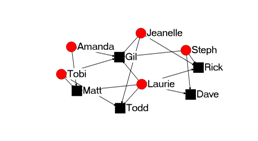

BACKGROUND
Tom Valente's research has been focused primarily on substance abuse prevention, treatment programs, and on the evaluation of health promotion programs. Of special interest to him is the interaction of social networks and the diffusion of innovations, a field in which he is widely published. Provided below are references to several publications and related data sets.
Note that the first two publications relate directly to the first two surveys: Tobacco Prevention and Substance Abuse; the remainder of the publications are more general in scope, discussing methods and theory often relying on data sourced from the last three surveys.
These last three surveys, relating to the studies on Korean Family Planning, Medical Innovation and Brazilian Farmers (also used later for farmers in Nigeria and India), should be of special interest to network "newbie's." These are three classic diffusion studies initiated by earlier researchers, which have been extensively re-analyzed by many others (see bottom of this page for other references to these projects). Such re-analysis of existing network data is commonplace in social network research and has been quite useful comparatively illustrating various nuances and considerations in social network methods and theories.
An especially good summarization, discussion and analysis of the three commonly referred to classic diffusion studies is presented in Valente 1996.
REFERENCES
Valente, T.W., Chou, C.P., & Pentz, M.A. (in press). "The mediating role of social network density on the effects of promotions to increase adoption of evidence based substance abuse prevention." American Journal of Public Health. -- Data: Ego-networks; Measures: Degree.
Valente, T.W., Hoffman, B.R., Ritt-Olson, A., Lichtman, K., & Johnson, C.A. (2003)."The effects of a social network method for group assignment strategies on peer led tobacco prevention programs in schools." American Journal of Public Health, 93:1837-1843. -- Data: Ego-networks; Measures: Degree.
Valente, T.W. (2005). "Models and methods for innovation diffusion." In: P. J. Carrington, J. Scott, & S. Wasserman (Eds.) Models and Methods in Social Network Analysis. Cambridge, UK: Cambridge University Press. -- Data: Varies; Measures: Varies
Valente, T.W. (1995). Network Models of the Diffusion of Innovations. Cresskill, NJ: Hampton Press. -- Data: Varies; Measures: Varies
Valente, T.W. (1996). "Social network thresholds in the diffusion of innovations." Social Networks, 18:69-89. -- Data: Varies; Measures: Varies
SURVEYS
TobaccoPrevention.doc- see Valente et al. 2003
SubstanceAbuse.doc - see Valente, Chou & Pentz (In Press)
KoreanFamilyPlanning.doc - see Valente 2005, 1996, 1995; also see other publications listed below.
MedicalInnovation.doc - see Valente 2005, 1996, 1995; also see other publications listed below.
BrazilianFarmers (Note this consists of twelve separate documents)- see Valente 2005, 1996, 1995; also see other publications listed below.
For other analyses of the Korean Family Planning study data also see:
Rogers, E.M. and Kincaid, D.L. (1981). Communication Networks: A New Paradigm for Research. New York: Free Press.
Dozier, D.M. (1977). Communication Networks and the Role of Thresholds in the Adoption of Innovations. Ph.D. Thesis, Stanford University, CA.
Montgomery, M.R. and Chung, W. (1999). Social networks and the diffusion of fertility control in the Republic of Korea. In: R.Leete (Ed.) Dynamics of Values in Fertility Change. Oxford, UK: Oxford University Press.
Kohler, H.P. (1997) . "Learning in social networks and contraceptive choice." Demography, 34:369-383.
For other analyses of the Medical Innovation study data also see:
Coleman, J.S., Katz, E. and Menzel, H. (1996). Medical Innovation: A Diffusion Study. New York: Bobbs Merrill.
Burt, R (1987). "Social contagion and innovation: Cohesion versus structural equivalence." American Journal of Sociology, 92:1287-1335.
Marsden, P.V. and Podolny, J. (1990). Dynamic analysis of network diffusion processes. In: J. Weesie and H. Flap (Eds.) Social Networks Through Time. Utrecht, The Netherlands: ISOR.
Strang, D. and Tuma, N.B. (1993). "Spatial and temporal heterogeneity in diffusion." American Journal of Sociology, 99:614-639.
Van den Bulte, C. and Lillien, G.L. (2001). "Medical innovation revisited: Social contagion versus marketing effort." American Journal of Sociology, 106:338-353.
For other analyses and information on of the Brazilian (also Nigerian and Indian) Farmers study also see:
Herzog, W.A., Stanfield, J.D., Whiting, G.C, and Svenning, L. (1968). Patterns of Diffusion in Rural Brazil. Unpublished report. Michigan State University.
Rogers, E.M. Ascroft, J.R. and Röling, N.G. (1970). Diffusion of Innovations in Brazil, Nigeria, and India. Unpublished report. Michigan State University.
Guimarães, L. (1972). Communication Integration in Modern and Traditional Social Systems: A Comparative Analysis Across Twenty Communities in Minas Gerais. Ph.D. Thesis. Michigan State University.